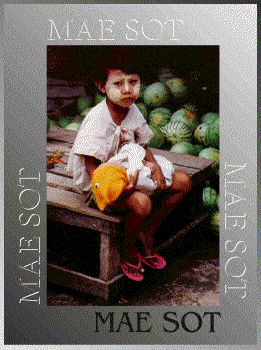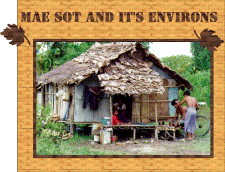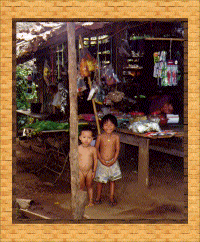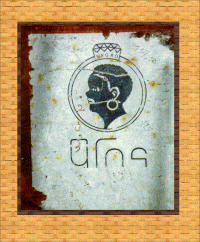
We then decided to go to Malaysia, but when our train was delayed over a half hour because of an "accident" and "flood", we decided it might be more prudent to go in the opposite direction, Northern Thailand, first. Because it was late in the day, we also decided to stay at a guesthouse for the evening but didn't stay at the same one we had been at because we had tired of it. When we sat down for dinner at this new guesthouse I got an uncomfortable feeling from the waiter whose eyes lingered on me longer than is typical of a heterosexual. Looking around the restaurant, I noticed that we had gone from a guesthouse staffed entirely by young Thai women with attitudes to a guesthouse where the employees were almost exclusively young, gay Thai men (at least they were more effeminate that the average Thai male we had seen).
I had ordered a Thai dish simply described as "peanut" on the menu. The waiter returned shortly after we ordered saying, "I'm sorry sir, but we have no peanut. We have cashew nut." When the surprise dish arrived, it was a small plate of freshly roated cashew nuts.


A new bridge for heavy traffic connecting the border of Thailand near Mae Sot and the Burmese border town of Myawaddy had been completed recently. A merchant we spoke with implied that the SLORC was blackmailing Thailand because they knew the Thai wanted to increase trade with Myanmar. Since the bridge was built the SLORC said they wouldn't open the border where the bridge was built until the river was dredged, but then that was not enough. This merchant, whose shop is filled with lacquerware from Pagan, Myanmar explained that the Burmese (meaning the SLORC) have made visiting Myanmar very unpleasant since they are trying to get as much money as they can from anyone they have contact with. She explained this by saying that many people whom she had met had told her they felt uncomfortable and had a difficult time relaxing on their on their vacations because the tension was so high. The portion of Myawady just on the Myanmar side of the border looks a older and poorer than the Thai side, but the difference is more striking a couple of hundred yards away and is becoming more striking by the day. Just north of the bridge, on the Myanmar side, is a fenced-in village of thatched roof homes while on the Thais side there are many tourist oriented buildings and many more structures currently being constructed. The border is closed, presumably because when it was open the economic drain on the Burmese side of the border was too great. We saw some young Burmese men and a youth strip off their longyis and swim to the other side of the narrow river. There was also a long, thin boat that ferried Burmese passengers across the river. Since the border is closed, at least to Thai and other non-Burmese wanting to go into Burma, there has been fighting in the area between separatists Karen peoples and the Burmese army which caused many Burmese residents of Myawaddy to flee to the Thai side of the river, but we don't know if the Burmese we saw throughout Mae Sot were refugees from this conflict or earlier arrivals. Mae Sot has a few wats which symbolize the Burmese presence in the area because they are said to be Burmese in style and Burmese writing can be seen there as well.

Mae Sot is a small town, but with a multinational flavor to it. We met one woman who had lived in the San Francisco Bay Area for five years, but returned to her home in Mae Sot because she was lonely for home. We met another man across from the mosque in Mae Sot who had lived in New York for seventeen years. He didn't offer why he had gone to Mae Sot and we didn't pry. There are Thai, Burmese, Karen, and some hilltribe peoples walking through the streets of Mae Sot as well and we saw a truck at our hotel with United Nations Relief Fund stenciled on it that may have been related to the relief efforts for the Karen refugee camps that are not too far from Mae Sot. We asked a man who spoke English if there was any fighting going on in the area between the Burmese military and the Karen. He said that the fighting ended with the rainy season. The Hmong were distinguishable by their baggy black silk, or silk looking pants which had colorful embroidery at the bottom. We also saw some little hilltribe women that we would have mistaken for little girls had I not taken a closer look because they were carrying children, but we couldn't identify which group they represented.


As in Chiang Mai and Bangkok, motorized bicycles and motorcycles are popular in Mae Sot. Even if the wildness wasn't apparent to us, it's still easy to see why Mae Sot was referred to as a Wild East town in our guidebook. The metaphorically rich sight of motorbikes parked in front of a small store, and a customer riding up on another motorbike to add to the small line out front nudged you to stretch your imagination. It is no stretch of the imagination though to compare the sight of motorcycle shops throughout the city of Mae Sot with the abundance of bicycle repair stands in the cities of China, including Beijing, that we visited. It is also symbolic of the disparate economic level of the two nations.
At 8:00 a.m., as we were walking down Prasat Withi Road, we heard chimes as if from a grandfather clock but we were sure they were coming from some recording. We looked around to see where the chimes were coming from and noticed a loudspeaker attached to one of the street light poles. Then the national anthem began playing. It was quite a site. The traffic policeman stopped all traffic and made a salute which he held throughout the anthem. Pedestrians, including a sole Burmese man, and bicyclists stopped in place, and men removed their hats until the anthem was over.
We were accosted by more children throwing open their palms in front of us in Mae Sot than we had ever been anywhere else. The children were generally clean and didn't look as poor as children we had seen begging in other places. I saw one young woman, I think she was Burmese, who was talking with her friend when a couple of kids approached her palms outstretched. She looked sternly at them and saying something, slapped the palm of the hand in front of her. The child did not look particularly upset and moved on to us. We told them "no" which they understood. It seems that along with that most internationally well known of English words, "hello", that "no" comes in a close second.

